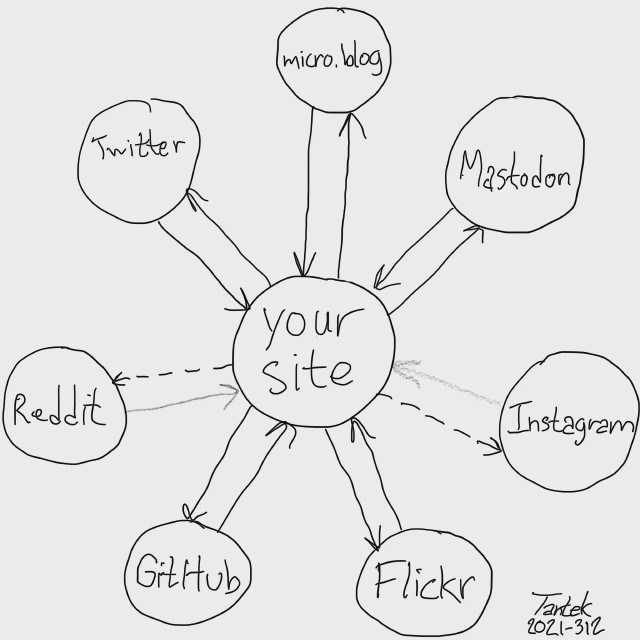I had been struggling with wanting to write at least weekly, but failing miserably–monthly at best. The pressure-to-write would build up and up and up, and finally I would put everything else aside to spasm out a long piece. It was not pleasant, but at least I was writing again.
Then I came across Mattias Ott’s commentary Writing, Fragments, and the Memex Method, which led me to Cory Doctorow’s piece The Memex Method. These resonated amazingly, with Ott’s piece helping me better appreciate Doctorow’s. Read them both!
Daily Writing Isn’t Just About Frequency
I’ve always thought about daily writing as being all about “building muscle memory,” but Doctorow and Ott enlightened me–that’s the least of its benefits. As Ott says,
I already knew that blogging – and having a personal website in general – is a superpower ….
I had heard before of Vannevar Bush’s groundbreaking essay “As We May Think” that directly inspired the invention of hypertext by Ted Nelson and Douglas Engelbart, which, in turn, had a huge influence on the WorldWideWeb project.
I also knew that a blog lets you document your thoughts and impressions in what can become an archive for your notes and a record of your experiences over time.
I knew that by sitting down and writing, your writing will inevitably improve.
And, I knew that some people are bad at writing regularly and that others – and that’s why we like to call them “writers” – aren’t.
What Cory describes in his post, however, goes far beyond those individual ideas. He combines them into an approach to blogging that is maybe the most compelling and empowering reason to have a blog.
Short Form Content (Fragments) as Writer’s Notebook
I had already been thinking about writing shorter pieces as part of trying to get on a quicker cadence–it’s easier to hit a daily cadence if quick, short pieces are an option.
But of course, short content published daily is so much more than that, as Doctorow makes clear. He explains that daily short-form writing is analogous to the writer’s pocket notebook, connects that to the original “web log” concept, and finally ties it in with Vannevar Bush’s “memex” concept from the 1945 paper As We May Think. Distilling a few of Doctorow’s key points:
- Ideas that are published have much more power than ideas that I just jotted down. I’m assembling my thoughts in a coherent enough manner to share them, and I’m signing my name to them, putting them out for comment and critique. With a daily writing routine, I’m largely “web logging” everything important that I’m thinking about.
- If you build a large collection of small published ideas, they tend to self-assemble into larger, more important essay-scale work. Doctorow calls it “nucleation in a supersaturated solution”–each small idea constantly triggers our minds: “this is a piece of something bigger, and maybe something important.” Doctorow:
Every now and again, a few of these fragments will stick to each other and nucleate, crystallizing a substantial, synthetic analysis out of all of those bits and pieces I’ve salted into that solution of potential sources of inspiration.
For me, the huge win is, instead of cathartic agony once a month trying to gather my thoughts and figure out what to write about, all I have to do is write daily, usually small pieces, and allow the larger essays to emerge naturally. I suspect that the quality and power of the writing will be significantly higher also–we’ll see.
And POSSE Too
Doctorow has influenced me in other ways, among them introducing me to IndieWeb and their POSSE principles.
POSSE is an abbreviation for Publish (on your) Own Site, Syndicate Elsewhere, the practice of posting content on your own site first, then publishing copies or sharing links to third parties (like social media silos) with original post links to provide viewers a path to directly interacting with your content.
Early this year I set up the new company-website-plus-blog, and took a relatively POSSE-compliant approach, leveraging the Hugo open-source static generation framework, with content being simple markdown, my CMS being Git / GitHub, and my hosting platform being “any of the players that let me host static content under a free plan”, currently CloudFlare Pages but I could change that with minimal work. I gained control of company content, as well as the long-form essays I was posting to the blog.
I had a major POSSE leak, however, when it came to short-form content. I post on LinkedIn to help get visibility for myself and Crafty, and all that content was basically throw-away. (LinkedIn does, actually, throw away my content, as I found when I tried to get back to some work from 2019.) Likewise, some of my posting on Mastodon is similar in nature (I pulled the eject handle on Twitter back in November), and again ended up being throw-away, in the sense that it’s possible that my mastodon server might disappear without me having a chance to get my content out. (The Mastodon community is working on this, and the situation is so much better than with Twitter, where the absolute worst has already occurred, at least until it gets worser.) Partly because of the siloed, throw-away nature of self-contained posting to LinkedIn and Mastodon, I’ve been only sporadically done these short posts, exactly wrong when one is trying to get known and build a following.
So along with adopting a daily writing habit, I decided to plug my POSSE leaks.
Updating Crafty’s Illustrated for Daily Writing and POSSE
I use the PaperModX theme in Hugo, which is of course a fork of PaperMod, which itself is a fork of Paper. PaperModX is well suited for “normal” size blog posts, but less so for microblogging. Of course, Hugo itself is a blank slate that grants me absolute control over what gets served up to a browser–just a matter of tweaking it, in my case pulling some elements out of the theme and customizing.
I’ve mentioned that generative AI tools like ChatGPT and MidJourney allow me to be more ambitious with my projects than I would otherwise have been. I would have hesitated if I had to devote a work week or more to enabling microblogging, but ChatGPT GPT-4 edition cut that task down enough that I was able to complete it in spare hours over the holiday weekend. I liked Simon Willison’s approach of having several flavors of micro content, and ended up implementing four:
- Elsewhere: A link to someone else’s content, and why I felt it was noteworthy
- Quote: A quotation with attribution and links to the author
- Imagery: Being a generative and geometric artwork fan, I love sharing others’ interesting creations, and this is a special micro format for exactly this purpose.
- Micro: A small thought that doesn’t fit neatly as one of the above.
Plugging the LinkedIn and Mastodon POSSE Leaks
From now on, any significant small idea gets done first on Crafty’s Illustrated as micro content using these new microformats. Then, when it comes time for the Syndicate Everywhere phase of POSSE, I’ll do a quick paste-edit of the content into the external platform, always with a link back to the permanent, definitive page on Crafty’s. Here’s a recent LinkedIn post version of the micro entry linked above.
So I am now some level of POSSE compliant–I’m not kidding!–and writing daily! Hurray!




